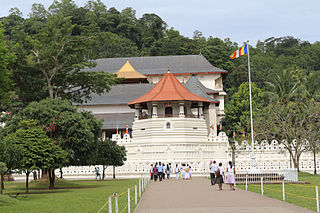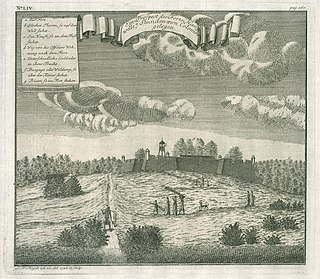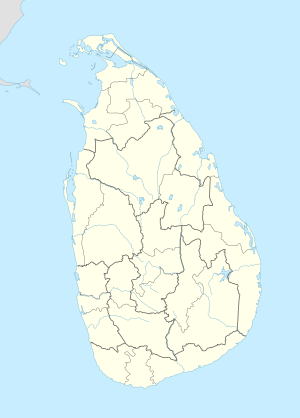
Kandy is a major city in Sri Lanka located in the Central Province. It was the last capital of the ancient kings' era of Sri Lanka. The city is situated in the midst of hills in the Kandy plateau, which crosses an area of tropical plantations, mainly tea. Kandy is both an administrative and religious city and the capital of the Central Province. Kandy is the home of the Temple of the Tooth Relic, one of the most sacred places of worship in the Buddhist world. It was declared a World Heritage Site by UNESCO in 1988. Historically the local Buddhist rulers resisted Portuguese, Dutch, and British colonial expansion and occupation.

The Kandyan Wars refers generally to the period of warfare between the British colonial forces and the Kingdom of Kandy, on the island of what is now Sri Lanka, between 1796 and 1818. More specifically it is used to describe the expeditionary campaigns of the British Army in the Kingdom of Kandy in 1803 and 1815.
Matale is a major city in Central Province, Sri Lanka. It is the administrative capital and largest urbanised city of Matale District. Matale is also the second largest urbanised and populated city in Central Province. It is located at the heart of the Central Highlands of the island and lies in a broad, green fertile valley at an elevation of 364 m (1,194 ft) above sea level. Surrounding the city are the Knuckles Mountain Range, the foothills were called Wiltshire by the British. They have also called this place as Matelle.
Great Rebellion of 1817–1818, also known as the 1818 Uva–Wellassa Rebellion , was the third Kandyan War in the Uva and Wellassa provinces of the former Kingdom of Kandy, which is today the Uva province of Sri Lanka. The rebellion started against the British colonial government under Governor Robert Brownrigg, three years after the Kandyan Convention ceded Kingdom of Kandy to the British Crown.

The Matale rebellion, also known as the Rebellion of 1848, took place in Matale city, Ceylon against the British colonial government under Governor George Byng, 7th Viscount Torrington. It marked a transition from the classic feudal form of anti-colonial revolt to modern independence struggles. It was fundamentally a peasant revolt.
Weerahannadige Francisco Fernando, colloquially known by his nickname Puran Appu is one of the notable figures of Sri Lanka's post-Kandyan history. Regarded colloquially as a national hero, his staunch resistance against British rule made him a symbol of independence and patriotism within many Sri Lankans. He was born on 7 November 1812 and raised in the coastal town of Moratuwa. He left Moratuwa with his family at the age of 13 in the aftermath of a village dispute and stayed in Ratnapura with his uncle, who was the first Sinhalese proctor, eventually settling in Uva Province. In early 1847, he met and married Bandara Menike, the daughter of Gunnepana Arachchi in Kandy.

The Kingdom of Kandy was a monarchy on the island of Sri Lanka, located in the central and eastern portion of the island. It was founded in the late 15th century and endured until the early 19th century.

Sir John D'Oyly, 1st Baronet was a British colonial administrator.
Wansapurna Dewage David alias Gongalegoda Banda was the leader of the Matale rebellion in 1848, pretender to the throne of Kandy and a national hero of Sri Lanka.

The Kingdom of Sitawaka was a kingdom located in south-central Sri Lanka. It emerged from the division of the Kingdom of Kotte following the Spoiling of Vijayabahu in 1521. Over the course of the next seventy years it came to dominate much of the island. Sitawaka also offered fierce resistance to the Portuguese, who had arrived on the island in 1505. Despite its military successes, Sitawaka remained unstable, having to contend with repeated uprisings in its restive Kandyan territories, as well as a wide-ranging and often devastating conflict with the Portuguese. Sitawaka disintegrated soon after the death of its last king Rajasimha I in 1593.
Major General Deshamanya Alexander Richard Udugama, was a Sri Lankan soldier, politician and diplomat. Former Army Commander (1964–1966), he was elected as Member of Parliament for Matale from 1970 to 1977 and served as Sri Lankan Ambassador to Iraq from 1979 to 1982. He was accused of an alleged coup d'état in 1966.
The Danture campaign comprised a series of encounters between the Portuguese and the Kingdom of Kandy in 1594, part of the Sinhalese–Portuguese War. It is considered a turning point in the indigenous resistance to Portuguese expansion. For the first time in Sri Lanka a Portuguese army was essentially annihilated, when they were on the verge of the total conquest of the island. A 20,000-strong Portuguese army, led by Governor Pedro Lopes de Sousa, invaded Kandy on 5 July 1594. After three months, severely depleted by guerilla warfare and mass desertions, what remained of the Portuguese army was annihilated at Danture by the Kandyans under King Vimaladharmasuriya. With this victory, the Kingdom of Kandy emerged as a major military power; it was to retain its independence, against Portuguese, Dutch, and British armies, until 1815.
The 1915 Sinhalese-Muslim riots was a widespread and prolonged ethnic riot in the island of Ceylon between Sinhalese Buddhists and the Ceylon Moors. The riots were eventually suppressed by the British colonial authorities.
Barnes Ratwatte was a Ceylonese colonial-era legislator and a headman. He was a member of the State Council and the Senate of Ceylon. He was appointed to the posts of Rate Mahatmaya of Balangoda and Dissawa by the British. He was the father of Sirimavo Bandaranaike, the first female prime minister in the world.

Sinhalese–Portuguese conflicts refers to the series of armed engagements that took place from 1518 to 1658 in Sri Lanka between the native Sinhalese and Tamil kingdoms and the Portuguese Empire. It spanned from the Transitional to the Kandyan periods of Sri Lankan history. A combination of political and military moves gained the Portuguese control over most of the island, but their invasion of the final independent kingdom was a disaster, leading to a stalemate in the wider war and a truce from 1621. In 1638 the war restarted when the Dutch East India Company intervened in the conflict, initially as an ally of the Sinhalese against the Portuguese, but later as an enemy of both sides. The war concluded in 1658, with the Dutch in control of about half the island, the Kingdom of Kandy the other half, and the Portuguese expelled.
Lt.-Gen. Hay MacDowall was a Scottish officer in the British Army who was the sixth General Officer Commanding, Ceylon. He was appointed on 19 July 1799. He was succeeded by David Douglas Wemyss. Fort MacDowall in Matale was named due to his involvement during Kandyan Wars. Only the remnants of gateway and portion of the ramparts are exist today.

Sri Lanka–United Kingdom relations, or British-Sri Lankan relations, are foreign relations between Sri Lanka and the United Kingdom.

Hanwella fort was located in Hanwella, Colombo, on the banks of the Kelani River. Hanwella, which means 'skin sands', was the site of an ancient ferry route across the river. Malwana fort was situated about 15 km (9.3 mi) on the other side of the Kelani River.

Veera Puran Appu is a 1978 Sri Lankan Sinhala epic biographical film directed by Lester James Peries and produced by former cabinet minister Tyronne Fernando for Shalanka Films. It stars Ravindra Randeniya and Joe Abeywickrama in lead roles along with Malani Fonseka and Tissa Abeysekara. Music composed by Premasiri Khemadasa. It is the 399th Sri Lankan film in the Sinhala cinema.
The Jayewardene family is a Sri Lankan family that is prominent in law and politics. Along with many members who have been successful politician across generations, the family includes Presidents and Prime Ministers of Sri Lanka.












